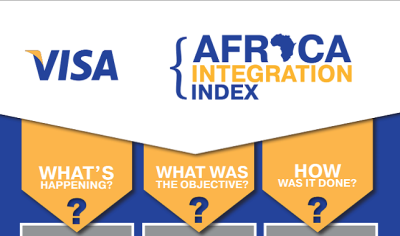Visa in Kenya has launched the Visa Africa Integration Index that measures the degree of economic integration within key trade corridors of sub-Saharan Africa, namely East Africa, West Africa and Southern Africa.
Jabu Basopo, GeneralManager for Visa in East and Southern Africa, said: “There is growing evidence that supports the argument that cross-border interactions, or openness, drives economic growth and socio-economic advancement.
The Index is built from country-level macroeconomic data, and a wealth of proprietary data drawn from Visa in sub-Saharan Africa, that sum to more than 4 million observations measured across 19 elements. The final outputs are economic integration scores at the country and regional levels measured on a semi-annual basis for the period 2011-2013.
The study offers a detailed analysis of key country clusters in sub-Saharan Africa, revealing strengths and areas of growth potential.
The clusters are:
- East Africa: Kenya, Uganda, Rwanda and Tanzania
- Southern Africa: South Africa, Angola, Mozambique, Zimbabwe and Zambia
- West Africa: Nigeria and Ghana
The 11 constituent countries are highly representative of the region, with a combined population of 437 million people, or 55 percent of the total population at the end of 2012. The study was carried out in conjunction with Professor Adrian Saville, Visiting Professor of Economics at the Gordon Institute of Business Science (GIBS) in Johannesburg.
Four key metrics to measure integration were used: the flow of goods and services or trade (T), financial integration and the movement of capital (C), the flow of information and knowledge (I) and the movement of people (P).
This TCIP model assigns a numeric value to the level of integration, with the global median score being 100.
Findings
Southern Africa cluster Visa Africa Integration Index Score
South Africa 63.3
Mozambique 42.4
Zambia 35.8
Zimbabwe 31.1
Angola 28.8
West Africa cluster Visa Africa Integration Index Score
Ghana 52.1
Nigeria 40.6
East Africa cluster Visa Africa Integration Index Score
Kenya 53.9
Uganda 48.7
Rwanda 47.3
Tanzania 45.3
Professor Saville said that Africa is still the least integrated region in the world, but there are signs of change. “While improving off a modest base, the countries that make up the Index have undergone positive structural transformation over the past decade.
“The Index offers both recent and robust evidence of this: all 11 countries show improvements in economic integration over the period measured, namely the four half-year periods that make up 2011 and 2013.â€
Kenya’s Visa Africa Integration Index score has risen consistently over the period of the survey resulting in Kenya achieving the highest score in the region and the second highest of the countries in the study.
Interestingly, Kenya’s depth of global integration is far greater than the depth of regional integration. But the breadth of the country’s economic relationships with its neighbours is far stronger than its breadth with the rest of the world.
“This suggests that despite the progress recorded in the EAC in recent years, there is still substantial opportunity for Kenya to deepen its regional economic relationships in all the areas in which it is already active. This bodes well for Kenya and the East African cluster as there appear to be easy wins from pursuing extant relationships,†Basopo noted.
South Africa scores highest amongst the 11 countries for global integration with a score of 42.6 out of 50. Kenya scores highest for regional integration, scoring 27.5 out of 50, narrowly overtaking Ghana. But all of these countries – South Africa, Ghana, Kenya and the other eight – are a long way off the global median of 50.
The same observation holds for the underlying depth and breadth pillars that make up the index.
While South Africa scores highest for global depth (48.3 against the global median of 50) and global breadth (36.9); Mozambique scores highest for regional depth (27.3); and Kenya has the highest score for regional breadth (40.9).
Notably, none of these scores achieves the global median of 50. Therefore, while the economic transformation among these African countries is impressive, the index results flag the need for further structural improvements.
Visa expects the Index to continue provide insights on Africa’s regional integration and enable them to track changes and progress over time.



